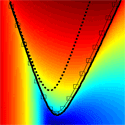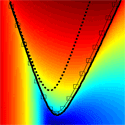Majorana states thrive under interactions
Majorana fermions (particles that are their own antiparticles) are considered ideal building blocks for logic gates in a quantum computer because of their noncommutative exchange statistics. In addition, these particles emerge as low-energy excitations of so-called topological phases, which are robust against perturbations that can lead to decoherence and would therefore be a stable platform for quantum computation.
Majorana fermions have yet to be realized experimentally. One of the simplest systems predicted to have a topological phase supporting the particles is a one-dimensional superconducting wire, in which spin-orbit coupling is strong, in an applied magnetic field. But how interactions—certain to exist in any real material—affect this phase has been unclear. Now, in a paper appearing in Physical Review B, Miles Stoudenmire at the University of California, Irvine, and colleagues have shown that although repulsive Coulomb interactions suppress the pairing-induced energy gap in the bulk of the one-dimensional wires, they may have a beneficial effect too. Using a variety of powerful tools such as the density matrix renormalization group and bosonization, Stoudenmire et al. show that interactions actually expand the range of chemical potentials or magnetic fields in which the topological phase is expected to occur. As a further boost to experimental efforts, it is found that strong interactions can even drive a system to produce Majorana excitations without an external magnetic field. – Sarma Kancharla





